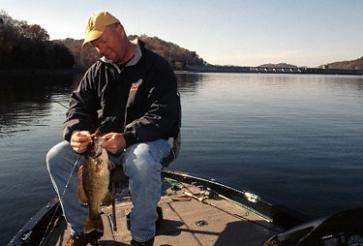
If I had to pick just one thing that most casual smallmouth anglers struggle with, it would be that they aren’t as good as they need to be at fishing deep water. They’re fine when the brown bass can be caught in 15 feet of water or less, but they struggle at depths greater than that.
That’s the problem, and luckily there’s a cure. It’s not immediate or foolproof, but it is a cure… if you’re willing to put in the hard work and concentration to make it work.
I’m going to help by making it as easy as I can. I think I can reduce it to just three steps.
Step 1: Learn to use your sonar equipment
Depthfinders have been standard equipment on bass boats for about 40 years now, and if you don’t know how to use yours, you have no one else to blame. Luckily, they’re getting easier and easier to use all the time.
To start with, forget all the nonsense you’ve heard about all the fine tuning you need to do to get the best image on your unit. It’s a bunch of bunk. Today’s modern sonar units will do the best job in the auto mode about 99 percent of the time. They’re set right in the factory and altering the settings will usually just mess you up.
Study the simulator, read the owner’s manual and spend some time with your unit while riding over well-known areas. Get familiar with it and know what you’re looking at on the screen.
And by all means, have an imagination and use it. It’s not enough to look at the pixels as they scroll across your screen. Imagine what it is they’re showing down there and think about how bass or bait will relate to it.
Step 2: Use light tackle and line
Heavy tackle is great when you can get away with it — like in dirty water or really heavy cover. But heavy tackle will adversely affect how you fish deep water for smallmouth bass.
It takes longer for heavy lines to get pulled to the bottom. Heavy lines are more visible to the bass. Heavy lines dull the action of your lures.
And by heavy I’m talking about anything over 10-pound test. I use a lot of 4-, 6- and 8-pound line for my smallmouth fishing here at Dale Hollow Lake and elsewhere. At night I might bulk up to 12-pound line, but most of my fishing is done with 6- and 8-pound lines — and that’s on the lake that produces the biggest smallmouth in the world. If we can get away with it here, you can use it where you catch smallmouth.
Step 3: Get off the bank
There’s an old saying that when you’re fishing the shoreline, 90 percent of the fish are behind you. They must have been talking about smallmouth bass when they came up with that one.
Yes, you can catch a few smallmouth near the banks almost any time of the year — if the banks are deep enough. But if you really want to catch them in numbers and if you really want to catch bigger brown bass, you’re going to need to get off the bank to do it.
That becomes easier once you get comfortable with your electronics and allow them to become your “underwater eyes.” It also gets easier once you have a little success in deep water, but that’s only going to come with time and patience. You didn’t win any races the first time you climbed up on a bicycle, and you can’t expect to load the boat the first time out fishing deep water. You’ll get better and better with time, though.
And that’s a real key to being a better smallmouth angler.
Until next time, if you have any questions or comments, I’d love to hear from you. Please e-mail me at Stephen@thesmallmouthguru.com.

